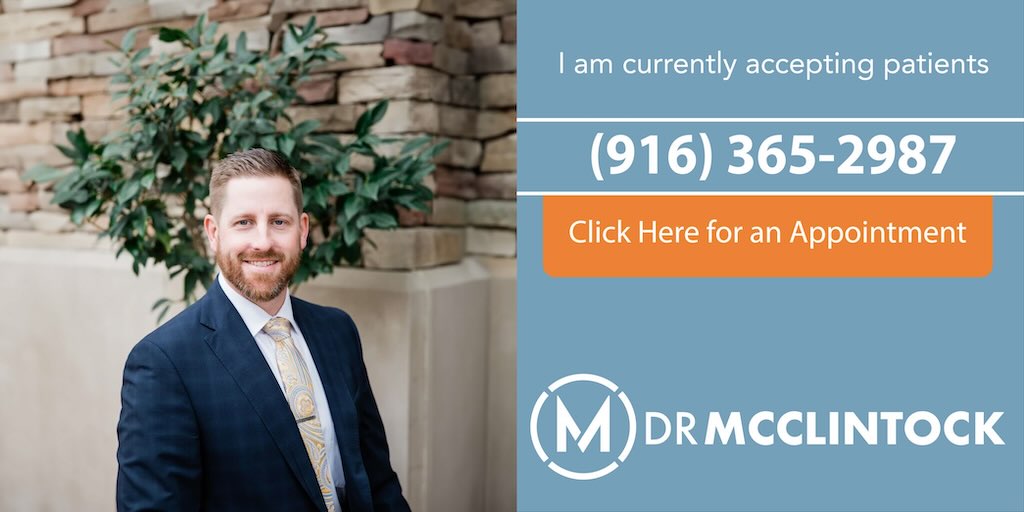Video Transcript
Hello, I’m Dr. Kyle McClintock in Roseville, California.
I wanted to do a brief little presentation to explain to patients out there who may have questions about shoulder arthritis. This is something that I treat on a very common basis. It’s a complaint that I deal with daily with patients who are coming in to see me. I thought it would be helpful if we just got some more information out to the public and to you as a patient if you might find yourself in this same situation, right?
You’ve been having shoulder pain; you go see your primary care doctor and they order an x-ray. Next thing you know, there’s a phone call and you’ve been told that you have shoulder arthritis, and now what, right? What do I do next? I put together this little presentation to kind of go over, you know, from my perspective how this plays out in each patient’s day-to-day activities, and really what’s available to them.
Before I get into that from a treatment standpoint and some of the meat of the presentation, I wanted to just give you a brief background about myself. I’m a board-certified orthopedic surgeon and I did an extra year of training, it’s called a fellowship, where I specialized in advanced shoulder and elbow reconstructive surgery. After my training was done, I did my residency in St. Louis, Missouri, and then fellowship was in Phoenix, Arizona. And once fellowship was completed, I relocated to California. Recently I came up to Roseville, California to establish a practice.
I treat a wide array of conditions. Shoulder arthritis is just one of those, but I specialize in upper extremity care. I wanted to make a more patient-centered experience where I team up with the patient to really restore their lifestyle and help them achieve, you know, that quality of life that they’re looking for from day-to-day and help them get back to doing the things that bring them joy and satisfaction. So that’s where I get my satisfaction. And hopefully, together we can partner on helping you do the same.
So, to the meat of the presentation. What is shoulder arthritis? I get this question a lot, and I guess I take this for granted because I deal with it day in and day out, and I’ve spent a good deal of my life, you know, learning about it, studying about it, and treating it, so this kind of is second nature for me. However, for patients, it can be kind of daunting because, you know, all you knew is that your shoulder was kind of bothering you and you were having some discomfort, and now you’ve been told that you have shoulder arthritis.
The technical term for shoulder arthritis is glenohumeral arthritis. And that just describes that joint between the glenoid, which is the socket of the shoulder, and the humeral head, which is the ball of the shoulder joint. During arthritis, what is actually occurring is that that smooth cartilage surface, the layer provides that smooth articulating surface on both ends of the joint is worn down. It gets degraded, and it starts to create a situation where pain can develop and all of those other things that come along with arthritis.
There are multiple things that can play a factor or role in the development of shoulder arthritis. Most of its just regular osteoarthritis or wear and tear arthritis, as we refer to it in orthopedics. You can have post-traumatic arthritis where these patients have had injuries in the past, and as a result of that injury they go on to develop arthritis at a later stage in life. Some arthritis is autoimmune based. These are patients who have something like rheumatoid arthritis or psoriatic arthritis. And these are processes where your body, the immune system of your own body kind of actually attacks the lining of the joint and that cartilage surface and causes that breakdown to occur. There’s not just a one size, or a one explanation, or one reason for all of it, there are different factors that kind of play into the development of that. And genetics, I didn’t list it here on this presentation, but we do know that there is also a genetic component to arthritis, and there can be different clinical scenarios where a patient is predisposed to developing arthritis in their joints as a result of some of their inherited genetic DNA.
The typical symptoms that we see from patients who are developing shoulder arthritis, obviously, number one is pain, right? You’re playing golf, you’re swimming, you’re skiing whatever the activity is, and you start to have that discomfort, it aches. A lot of people describe it as kind of a toothache feeling. It’s a deep-seated ache. It’s not really that kind of sharp stabbing pain.
The second thing that people will start to notice is a decrease in their range of motion. They develop some stiffness. This is really pronounced in external rotation, which is kind of reaching out to the side of your body as well as internal rotation behind the back. And that can be very limiting or debilitating from day to day as it relates to just simple activities of daily living, cleaning the house, taking a shower, getting dressed. I have patients who tell me they have a really hard time with very simple things as a result of that loss of motion.
One of the most uniform complaints that I get is difficulty sleeping at night. We tend not to sleep flat on our backs. We usually side sleep or most of us do anyway. When you develop arthritis in the shoulder it can be very difficult to get into a comfortable position when you’re trying to sleep, or once you fall asleep and you happen to roll over in the course of the evening, that pain, you know, jolts you from your sleep and really interrupts the ability to get quality, uninterrupted sleep.
Lastly, crepitus. Crepitus is the medical term that we use to describe that kind of crunching sound or popping sound that you hear when you just don’t have a nice smooth articulation for that range of motion. These are real common things that patients will come in and describe to me as I’m, you know, taking their history and examining them from day-to-day.
From the diagnostic perspective, shoulder arthritis is typically diagnosed with just a simple x-ray. It doesn’t require a CT scan or an MRI to diagnose arthritis in most scenarios. The x-ray is adequate. We can see the loss of joint space. We can see bone spurs that form, and we can see that process as it starts to work through that stage from a mild to moderate to severe form.
We use physical exams to help us determine the severity of the disease. We also use scoring systems, and this is just one little kind of rubric or screenshot here that I placed. It’s called Surgical Outcomes from a company that I use on a regular basis. Through this tool, we’re able to communicate a little bit more efficiently with patients. They can fill out surveys and take little quizzes, I guess you could call them, tests to really determine how their shoulder arthritis is affecting them from day to day. It gives us the ability to then kind of make a composite score and help determine the amount of disability that this is causing for you day in and day out. And that really helps us gauge the impact that it’s having on your life from day to day.
Then obviously the next question that most people are going to have is, “Well, what do I do about it, now that I know that I have it, and it’s a problem for me, and it wakes me up at night, and I can’t go play golf or pickleball anymore?” The treatment options that we utilize to treat arthritis of the shoulder are very similar to the treatment options that you would recommend or utilize to treat knee arthritis or hip arthritis or any of these other large joints in our body that are prone to developing this condition.
The first line of treatment for almost all cases is physical therapy and NSAIDs, or nonsteroidal anti-inflammatory drugs. These are things like Aleve, ibuprofen. Some of these are prescription, such as meloxicam or Mobic. And the goal with the first-line regimen of treatment is twofold. One, we want to decrease inflammation. In general, arthritis is an inflammatory process. It creates a lot of inflammation inside of the joint. It creates a lot of pain as a result of that inflammation. If we can attack the inflammation, get that under control and down to a more manageable level, then we’re able to have a positive impact on people’s ability to function from day to day, whether that’s at work, or playing sports, or hobbies, or skiing. And more importantly, really is at night when people have a really hard time sleeping.
The goal of the physical therapy is to help prevent some of that loss of motion that occurs once a patient develops arthritis. As the disease progresses from mild to moderate and severe, these range of motion limitations become more prominent. We’re trying to maintain the motion that we have and to maintain our function of that joint, in this case, the shoulder, by engaging in physical therapy for stretching exercises and to strengthen some of the muscles around the shoulder girdle so that the shoulder functions appropriately and allows you to accomplish the activities that you need to do from day-to-day.
A second-line treatment option, and we talk about this a lot with patients, and I do, you know, provide this service to patients on a very regular basis, is a cortisone injection. This is similar to ibuprofen, Aleve, those medications that are oral form, but it’s an intraarticular injection. We sterilize the skin; we place a needle into the shoulder joint, and we inject the cortisone directly into that inflamed joint so that it can have a really significant impact on the inflammation that’s associated with the arthritis.
This is really effective for patients who are having pain at night and who are having a really difficult time sleeping. I find it to be very beneficial in those situations. And for patients who have tried the oral anti-inflammatories and maybe just haven’t really had a significant amount of relief as a result.
I listed a few other things on here. Some people are familiar with hyaluronic acid injections. Those are the gel shots that you may have heard of. There’s limited evidence to support use of that in an arthritic shoulder. It’s not to say that it isn’t used or that some clinicians don’t use that for treating shoulder arthritis, but overall, by and large, across the board, it’s not a very commonly used treatment option for shoulder arthritis.
Something that’s a little bit more on the horizon is PRP, stem cells, these other types of treatments that we lump into a category called biologics. This is where we’re trying to take your own body’s natural healing elements, put them into a concentrated form, and deliver those into that arthritic joint to try to decrease that inflammatory process and maintain the longevity of the joint as you move forward with the disease.
The evidence is still very limited in regards to biologics. A lot of times in my clinical practice I use PRP, which is an acronym for platelet-rich plasma. We draw the patient’s blood here in clinic. It goes into a centrifuge, we spin it down, and we’re able to harvest that platelet-rich plasma that has all of those healing properties, and then we inject that into the joint. And I use that in situations where we’re in the very early stages of arthritis. So that mild stage. It really hasn’t been shown to be highly beneficial if somebody has moderate or severe disease. It’s kind of a very narrow window that we utilize that.
Finally, once we’ve exhausted all of our conservative measures, and the oral anti-inflammatories, the physical therapy, the injections haven’t really had a significant impact, then we talk about the more aggressive approach to treatment options, which is surgery.
I will say, kind of going back to the injection component before I get into the discussion about surgical options, there is evidence in the literature that does require us to kind of take a cautious approach with injections to the shoulder specifically. There is a bacteria that is common to our skin on our chest and our back that’s called C. acnes, and the risk with repetitive injections, when speaking of cortisone, is that along with kind of degrading some of the soft tissues, if you do it too much and too frequently is you run the risk of pushing some of that bacteria deep into the joint space and potentially developing a scenario where you increase your risk for developing an infection if you were ever to go on and have a shoulder replacement in the future. When we do use cortisone, we use it sparingly. It’s not something that we inject every month or every couple of months for years on end because there are some significant long-term risks that you open up yourself to if you do so.
When the conservative measures haven’t worked well and the disease is progressing, that’s when we start to discuss our options for shoulder replacement.
This is a picture of an anatomic shoulder replacement. As you can see on the x-ray, the humeral head is replaced with a metallic implant. There’s a stem down the humeral canal, and the socket or the glenoid is resurfaced, and a spacer is cemented into position on the socket side so that now we have a nice smooth bearing. We’ve gotten rid of any bone spurs. We’ve recreated that joint space. Patients are able to regain function and activity of the joint.
A couple of key points when it comes to an anatomic shoulder replacement, it requires an intact rotator cuff to be functional. The rotator cuff is a group of four tendons that surround the humeral head or ball of the shoulder. And it grabs onto the humeral head and stabilizes it in the socket as you raise your arm up or out away from your body. We refer to it as a dynamic shoulder stabilizer. If that structure is compromised, then those patients have very poor outcomes if you try to do an anatomic recreation of the joint, or reconstruction, and we’ll talk about what to do in those scenarios.
Right now, as it stands, they have about a 95% survival rate at 10 years. And these numbers are getting better and better as we’ve improved our technology and the manufacturing process and the materials that we use to replace a shoulder. We expect that if done properly, and a patient has an intact rotator cuff, that they will have very good pain relief, very good function of their shoulder, and it will allow them to get back into a lot of the activities that they previously enjoyed.
A lot of questions that I get when I’m having this conversation with patients really stem from a patient’s desire to get back to an active lifestyle. Will I be able to play tennis? Will I be able to water ski or go snow skiing? And the answer to that question is yes.
The goal with this surgery is to restore back the lifestyle that you want to lead in a way where you’re not having pain, not having discomfort, you’re able to sleep at night, and you can move on with your life as you get further out from that shoulder replacement surgery, and you go through the rehab process and put in the work that’s required to rehab the joint.
I mentioned in that slide that patients, in order to have a successful outcome with an anatomic shoulder replacement, require an intact rotator cuff. And there are patients who come to see me who have shoulder arthritis but have a compromised rotator cuff. And that condition is a little bit separate from glenohumeral joint arthritis. We refer to that as rotator cuff tear arthropathy, which is just, you know, a big fancy term that describes the coexistence of rotator cuff tear or pathology with shoulder arthritis.
In those scenarios, we have to use a different implant. We still have the option to replace the shoulder, but we have to use a, it’s called a reverse because we basically flip the geometry of the joint. As you can see in this picture, there’s a ball attached to the socket. And what used to be the humeral head or ball now has a dish or a cup that’s attached on that end. And this allows us to restore the integrity of the joint and eliminate the arthritis, allow for return of function, a significant reduction in pain, and getting back to activities of regular life.
If you look here, the survival data at 10 years is 90 to 95%. So still very good survival data. And again, it’s improving. This is where a lot of the technology when it comes to shoulder arthroplasty or shoulder replacement procedures is being poured into this reverse shoulder replacement, and for a good reason. I think if you look across the board there are more reverse shoulder replacements being performed on patients annually than there are anatomic shoulder replacements because we do see this in a more elderly patient population where they have a compromised rotator cuff.
This has been a really significant influence in shoulder arthroplasty, and what we are able to offer patients, and actually is one of the main drivers or reasons why I wanted to do a shoulder and elbow fellowship because this is my one of my favorite surgeries to perform.
I remember as a medical student and as a resident early on in my training, just being completely, really, I don’t want to say surprised, but just kind of blown away, I guess, by the ability that we had to completely change someone’s anatomy at their joint and restore function. It just seemed so foreign and so fascinating, and it’s been something that has really kind of propelled my interest in shoulder surgery and something that I’m very passionate about.
This is improving every, you know, every year we’re getting better technology. Our outcomes are improving and we’re getting some really good long-term data nowhere in the United States since this was approved in the early 2000s.
I wanted to show you guys a couple of videos here of some of my post-op patients. I kind of took some snippets from different timeframes in the recovery period. This is a video of a gentleman who had a reverse shoulder replacement six weeks prior to this video being taken. He has really good range of motion for this early on in the recovery process. His pain control is improving significantly and he’s, at this point, really happy.
This next video here is a patient, a different patient, who also underwent a right reverse total shoulder arthroplasty. He’s about three months out from surgery and he’s doing really well. He’s regaining his range of motion. You can see his external rotation reaching away from the body and behind his back is really coming along nicely, and his pain is significantly improved. A patient who’s very happy early on in his recovery.
Lastly, I wanted to throw in somebody who’s kind of more at the tail end of their rehab and recovery from a shoulder replacement. This is a female patient who underwent a left shoulder replacement. Hers is also a reverse, and she has excellent function and range of motion given what she started with. She has no pain, and she is extremely happy with her outcome.
The reason that I chose to show you three videos of patients who had undergone a reverse shoulder arthroplasty is because one of the questions that I often get from patients who have heard about this procedure is that they wonder what kind of function will they have long-term given the fact that we’ve totally changed around the anatomy of the shoulder. And so, you know, everybody’s heard stories from a friend or a neighbor, or somebody who kind of made them nervous. I wanted to demonstrate that this is a very effective procedure at eliminating pain and helping to restore function of the shoulder to patients who find themselves in a situation where a reverse is indicated over an anatomic reconstruction. We can really help people get back to active lifestyles. That’s very reassuring for them, and it’s also rewarding for me.
Just, in summary, this presentation was just meant to be kind of a brief little synopsis of shoulder arthritis. It’s a common problem. It’s growing as our Baby Boomer population expands. We’re seeing the number of shoulder replacement procedures performed in the United States every year just really skyrocketing and taking off. This is a very common situation that a lot of patients find themselves in.
There are really good options from conservative treatment standpoint and surgical options to help address this pain once you’ve exhausted your conservative measures. And the goal is always to improve mobility and quality of life, whether that’s through nonoperative or operative management.
I hope some of this information has been useful to you today. I really love treating shoulder arthritis. If it’s something that you’ve been struggling with or if you’re having shoulder pain, I’d love to go over your images. Have you come in, do a good physical exam, take a history from you, and really develop a treatment plan that meets your goals and your objectives and allows you to get back to the lifestyle that you’re trying to live in the shortest amount of time possible.
And I look forward to seeing you in the near future.





